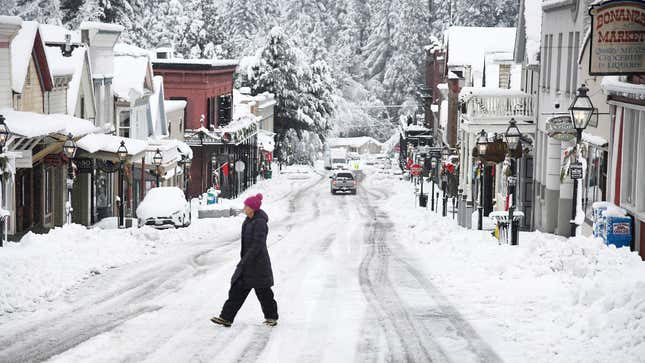
A series of winter storms in California over the Christmas weekend dumped snow all over the Sierra Nevada mountains. This is good water news for the upcoming year following a bone-dry summer that set several worrying new records for water scarcity.
California’s Department of Water Resources reported Tuesday that snowfall totals were 145% of normal for this date in the Northern Sierra Nevadas, 157% in the Central Sierra Nevadas, and 161% of normal in the Southern Sierra Nevadas. The snow totals for this month broke a 50-year record in Tahoe by more than 23 inches (58 centimeters): total December snowfall on Monday measured 16 feet and 1.7 inches (4.92 meters), according to the UC Berkeley Central Sierra Snow Lab. Of that snow total, 38.9 inches (98.8 centimeters) fell in 24 hours. The huge amount of snow in the area means that the Tahoe Basin is currently at 200% of average for snow water equivalent—the measurement of how much water would be produced when all the snow melts—for this time of year.
Snow is hugely important in California. About a third of the state’s water each year comes from the winter snowpack in the Sierra Nevadas, which melts in the spring to form runoff that replenishes rivers, streams, and reservoirs. A below-average snowfall in the winter can spell big trouble for water availability during the summer. In April, CalWater reported that the Sierra Nevada snowpack was 59% of normal levels, which was a factor in the record-breaking dry summer this year. It’s encouraging that the snowpack is off to a strong start this year: according to the Department of Water Resources, all of the snowfall in the state right now already makes up 49% of the usual April 1 totals.
Combined with some pre-Christmas storms that helped the snowpack average jump from 18% to 98%, California is having the strongest start to its Water Year—which begins every October 1—in more than 40 years. But don’t celebrate too soon: one great snow year doesn’t mean that the West’s dire water conditions are all solved. The overallocation of water in the West combined with rising temperatures has led to a mounting crisis that won’t be course corrected with one or two wet years.
Even in the wet and snowy weather, all of California is still currently experiencing at least moderate drought conditions, according to the U.S. Drought Monitor, with more than 92% of the state in severe drought and nearly 80% in exceptional drought, the second- and third-most severe levels. More than 23% of California, including much of the agriculture-heavy San Joaquin Valley, is still experiencing exceptional drought conditions—the most serious level of drought. At the height of the 2012-2016 drought crisis, 100% of the state was in severe drought.
Climate change, too, has a huge hold on what happens in the Sierra Nevadas. The snowpack in the West has declined by 21% since 1915, roughly the equivalent of the capacity of Lake Mead. A recent study published in Nature Reviews Earth & Environment found that snowpack in the Sierras could be low or absent for up to five years at a time by the late 2040s if emissions continue unchecked; researchers predict that a full decade without snow in the region could pass by the late 2050s under this scenario. And even in robust snow years, climate change can still wreak havoc: higher temperatures earlier in the spring means the release of runoff from the snowpack is earlier and more unpredictable than in the past, making the management of all that water more difficult and guaranteeing more drier months in the summer.
“It’s been a pretty impressive December,” Dan McEvoy, regional climatologist for the Western Regional Climate Center, told the Reno Gazette-Journal. “If I had to emphasize one point, it’s that the drought’s not over. We need the storms to continue through the winter.”